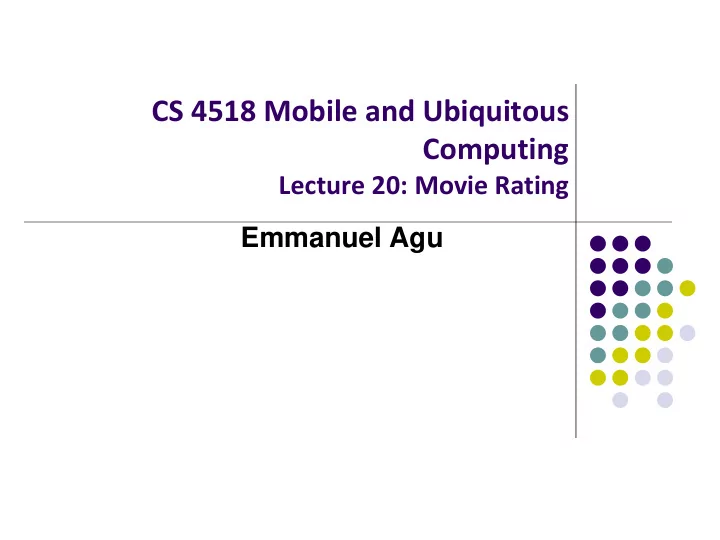

CS 4518 Mobile and Ubiquitous Computing Lecture 20: Movie Rating Emmanuel Agu
Your Reaction Shows You Liked the Movie
The Problem: Rating Movies & Videos Your reactions suggest you liked the movie: Automatic content rating via reaction sensing, X Bao, S Fan, A Varshavsky, K Li, R Roy Choudhury, in Proc Ubicomp 2013 Current Rating System: Today’s ratings are mostly 1 -5 rating, inadequate 1. Eliciting more in-depth, careful rating from users is difficult, requires incentives 2. Figure 1: Rating of Avatar from rotten tomatoes
Key Observations Smartphone sensors can be used to infer user rating while users watch YouTube videos Laughter detected (microphone) => Funny Stillness while watching (accelerometer) => Intense drama Head turn (front facing camera) + talk (microphone) => Lack of interest Fast forwarding movie => Lack of interest Paper Goal : Research and Develop movie rating system called Pulse Learns mapping between the sensed reactions and ratings Automatically computes users’ ratings.
Pulse Vision Movie’s playback timeline can be annotated with reaction labels (e.g., funny, intense, warm) Senses user reactions and translates them to an overall system rating. In future, tag-cloud of these sensed user reactions can augment movie ratings Pulse Vision
SYSTEM OVERVIEW Main modules : Reaction Sensing and Feature Extraction (RSFE), Collaborative Labeling and Rating (CLR), and Energy Duty-Cycling (EDC). RSFE: processes the raw sensor readings and extracts features to feed to CLR. CLR: The CLR module processes each (1 minute) movie segment of the movie to create “semantic labels” + “segment ratings”. Segment ratings are merged to yield the final “star rating ” Semantic labels are combined to create a tag-cloud. EDC: minimizes energy consumption due to sensing.
System design: RSFE Visual: Pulse detects the face through camera, detects eyes using blink detection, generates visual features and tracks key points (face, eyes, lip) Acoustic: Voice Detection: Activates microphone, records ambient sounds, separates user’s voice Laughter Detection: Pulse assumes that acoustic reactions during a movie are either speech or laughter Once human voice is detected, classified as speech or laughter Support vector machine (SVM) classifier using Mel-Frequency Cepstral Coefficients (MFCC) as features. Control operations: Users skip boring movie segments, rewind interesting segments Visual, acoustic features and control operations forwarded to CLR module
Pulse Evaluation Methodology • 11 volunteers, 6 new movies, watch movies using Pulse video player • After watching: rate segments, perception label, final “star” rating Challenges Predicting human judgment, minute by minute, is quite difficult. • Heterogeneity in users behavior Some users naturally fidgety, others still • Heterogeneity in environment factors Eg: Same user may watch same movie differently at office VS. at home • Heterogeneity in user tastes Different users may rate same movie differently
Final Results • Performance of Final “Star” Rating Average error of 0.46 on a 5 point scale. Figure 18. (a) Mean segment ratings and corresponding users’ final ratings.
What Else Sensed?
Other Sensable Behaviors Mood (happy, sad, etc) Predictors: e.g. late night browsing (sad) Boredom of Smartphone User Addicted Smartphone Usage
Recommend
More recommend